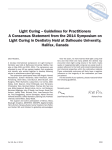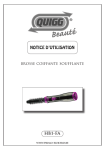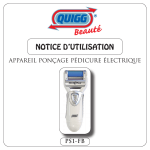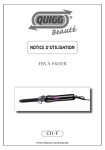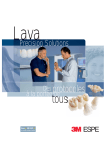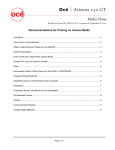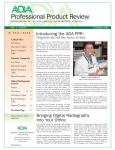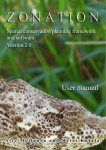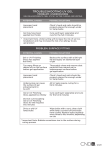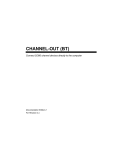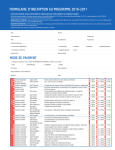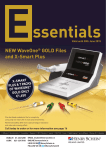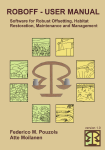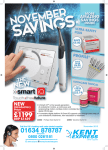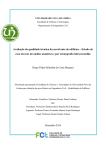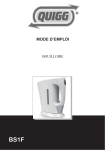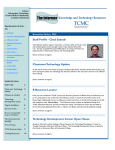Transcript
Issues and People Light Curing Guidelines for Practitioners A Consensus Statement from the 2014 Symposium on Light Curing in Dentistry, Dalhousie University, Halifax, Canada* When selecting a light curing unit (LCU): • Recognize that all lights are not created equal. Use a LCU from a manufacturer who provides contact information, a user manual, and service. Preferably the LCU should have received a favourable report or certification from a reputable independent 3rd party. When properly performed, light curing of resin-based restorations produces better physical and chemical properties of the restoration, stronger bonds between the restoration and tooth, improved colour stability and a higher probability of a successful long-term clinical outcome. Light curing performed incorrectly can result in premature failure of the restoration and potentially more tooth decay, resulting in larger restorations that may require endodontic treatment, or other costly procedures. Undercuring resin-based fillings—by curing for an insufficient length of time, improperly positioning the light curing unit (LCU) over the restoration, or using the wrong type of LCU—is thought to contribute to the higher failure of resin-based restorations placed in general dental offices compared to the results from controlled clinical trials. To discuss and address these concerns, an international symposium on light curing in dentistry was held at Dalhousie University in Halifax on May 29–30, 2014. The symposium was attended by 40 key opinion leaders from academia and industry who worked together to develop a Consensus Statement with advice on light curing for practitioners. The symposium participants were Bob Angelo, Ahmed Abuelyaman, Suham Alexander, Sibel Antonson, Steve Armstrong, Oliver Benz, Uwe Blunck, Ellen Bruzell, John Burgess, Peter Burtscher, Liang Chen, Ivo Correa, Matt Dailey, Colin Deacon, Omar El-Mowafy, Jack Ferracane, Christopher Felix, Reinhard Hickel, Thomas Hill, Neil Jessop, Hilde Kopperud, Daniel Labrie, Hui Lu, Lori Moilanen, Bernhard Möginger, John O’Keefe, Joe Oxman, Frank Pfefferkorn, Jeffrey Platt, Richard Price, Jean-François Roulet, Fred Rueggeberg, Janine Schweppe, Adrian Shortall, Howard Strassler, Jeffrey Stansbury, Byoung Suh, Andreas Utterodt, David Watts and Stacy Wyatt. The support of Benco, BISCO, BlueLight Analytics, DENTSPLY, 3M-ESPE, Gigahertz-Optik, Henry Schein, Heraeus-Kulzer, Ivoclar Vivadent, Kerr, Patterson Dental, SDI, and Ultradent is gratefully acknowledged. Additional Resources on Oasis Discussions • Buyer Beware! Not all Curing Lights are Equal oasisdiscussions.ca/2014/07/28/lc-3 •An Enlightening Look at Light Sources in Dentistry oasisdiscussions.ca/2014/07/17/cl-2 • Practical How To: How do you clean your light curing unit? oasisdiscussions.ca/2014/07/03/htcl •Effective Use of Dental Curing Lights: A Guide for the Dental Practitioner oasisdiscussions.ca/2013/11/29/dcl • Know the key performance parameters of your LCU, when new: (i) the light output (averaged irradiance over the beam incident area in mW/cm2 and spectral output from the LCU), (ii) whether the beam has a uniform and effective output (profile) across the light tip, and (iii) the diameter of the light beam. • Be cautious when using high (above 1,500 to 2,000 mW/cm²) output LCUs that advocate very short (e.g., 1 to 5 seconds) exposure times. When used for such short times, it is critical that the light tip is stabilized over the resin during exposure. Although some resin composites are matched to specific high output curing lights, high output LCUs may not adequately cure all of today’s resincomposites to the anticipated depth when used for short exposure times. Seek peer-reviewed literature validating the efficacy and safety of such lights and materials. Before you light cure, remember to: • Regularly monitor and record the light output over time, with the same measurement device and light guide. Repair or replace the LCU when it no longer meets the manufacturer’s specifications. • Inspect and clean the LCU before use to ensure it is on the correct setting, in good working order, and free of defects and debris. • Consider that every resin-based material has a minimum amount of energy that must be provided at the correct wavelengths to achieve satisfactory results. [Energy (Joules/cm2) = output (W/cm2) x exposure time (seconds)]. However, minimum irradiation times are also required. • Follow the light exposure times and increment thickness recommended by the resin manufacturer, making allowances if you use another manufacturer’s light. Increase your curing times for increased distances and darker or opaque shades. • Select a LCU tip that delivers a uniform light output across the light tip and that covers as much of the restoration as possible. Cure each surface independently, using overlapping exposures if the light tip is smaller than the restoration. • Position the light tip as close as possible (without touching) and parallel to the surface of the resin composite being cured. • Stabilize and maintain the tip of the LCU over the resin composite throughout the exposure. Always use the appropriate “blue blocking” glasses or a shield to protect your eyes as you watch and control the position of the curing light. Precautions: • Avoid conditions that will reduce light delivery to the resin-composite, e.g.,: – Holding the light tip several millimetres away. – Holding the light tip at an angle to the resin surface. – Dirty or damaged light-guide optics. • Supplementary light exposures should be considered under circumstances that may limit ideal light access, such as shadows from matrix bands, intervening tooth structure, or from restorative material. • Beware of potential thermal damage to the pulp and soft tissues when delivering high energy exposures or long exposure times. • Air-cool the tooth when exposing for longer times, or when using high output LCUs. • Never shine the LCU into the eyes, and avoid looking at the reflected light, except through an appropriate ‘blue-blocking’ filter. • Testing surface hardness of the resin-composite in the tooth using a dental explorer provides NO information about adequacy of curing depth. • Further resources on light curing will be posted on Oasis Discussions • * Blanket copyright license is given for this information to be freely used, in whole or in part, for all derivative works without permission from the copyright holder. 22 | Volume 1 Issue 6 Volume 1 Issue 6 | 23
